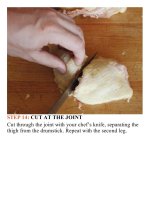The food lab better home cooking through science ( PDFDrive ) 703
Bạn đang xem bản rút gọn của tài liệu. Xem và tải ngay bản đầy đủ của tài liệu tại đây (133.9 KB, 2 trang )
something else going on here.To understand what’s really
happening, you have to look at the structure of turkey
muscles.Musclesaremadeupoflongbundledfibers,each
onehousedinatoughproteinsheath.Asthemeatheats,the
proteinsthatmakeupthesesheathswillcontract.Justlikea
squeezing a tube of toothpaste, this causes juices to be
forcedoutofthebird.Heatthebirdtomuchabove150°For
so,andyouendupwithdry,stringymeat.
Salt helps mitigate this shrinkage by dissolving some of
the muscle proteins (mainly myosin). The muscle fibers
loosen up, allowing them to absorb more moisture and,
more important, they don’t contract as much when heated,
ensuring that more of that moisture stays in place as the
turkeycooks.Soundsgreat,right?Butthere’sacatch.
TheProblemswithBrining
There are two major problems with brining. First off, it’s a
majorpaininthebutt.Notonlydoesitrequirethatyouhave
avesselbigenoughtosubmergeanentireturkey(common
options are a cooler, a big bucket, or a couple of layered
heavy-duty garbage bags tied together with hopes and
prayersagainstbreakage),butitalsorequiresthatyoukeep
everythinginsideit—theturkeyandthebrine—coldforthe
entire process.With an extra-large bird, this can be for as
long as a couple of days, meaning that you either give up
using the main compartment of your fridge at the time of
yearthatyoumostneeditoryoukeepaconstantsupplyof
icepacksoricerotatingaroundthebirdtokeepitcold.
Second,asHaroldMcGeeoncepointedouttome,brining
robs your bird of flavor. Think about it: The turkey is
absorbingwaterandholdingontoit.That30to40percent
savingsinmoisturelossisnotreallyturkeyjuices—it’splain
old tap water. Many folks who eat brined birds have that
verycomplaint:it’sjuicy,butthejuiceiswatery.
I’d seen a few solutions (solutions, get it? ha-ha) offered
for this problem, so I decided to test them all out side by
side. I ran my tests on chicken breasts, which have
essentially the same fat content and protein structure as
turkeybreastsbutaresmallerandeasiertoworkwith.
BriningSolutions
By far the most common alternative to wet-brining is plain
old salting (i.e., dry-brining). When you salt a turkey or
chicken breast, meat juices are initially drawn out through
theprocessofosmosis.Asthesaltdissolvesinthejuices,it
formswhatamountstoaveryconcentratedbrine;see“How
toDry-BrineaBird,”here.
I’vealsoheardpeopleasktheveryobviousquestion,“If
briningintroducesbland,boringtapwaterintothebird,why
notbrineinamoreflavorfulsolution?”
Whynotindeed?Idecidedtofindout.
Here’swhatItried:
•Sample#1:Plain(untreated)
•Sample#2:Brinedovernightina6%saltsolution
•Sample#3:Heavilysaltedovernight
• Sample#4:Brinedovernightinchickenbrothwitha6%
saltcontent
• Sample #5: Brined overnight in cider with a 6% salt
content









